How To Build A Log Cabin Using Trees?
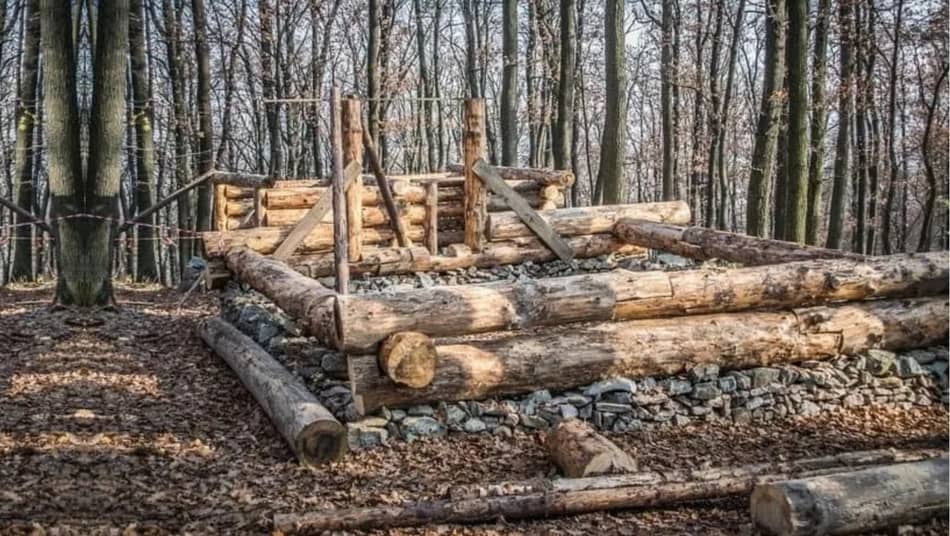
If you have access to a property with lots of trees, constructing a log house is a terrific way to take advantage of the available natural resources. Even if you have little or no experience in the construction industry, you can build a cabin, whether it’s for your permanent residence, a weekend getaway, or storage space. The various kits that are used to build a cabin on the marketplace should not deceive you, claiming that only professionals can create cabins that come with huge price tags. You shouldn’t have to break the bank to have a modern log cabin.
If you know how to pick the right logs, fell, prepare, and build a cabin using logs, owning your own land can save you a lot of money. To begin the process of building your own log home, you’ll need to understand how to choose the right trees for the job. So, let’s start.
Table of Contents
How To Build A Log Cabin Using Trees?
So How To Build A Log Cabin Using Trees? To build a log cabin using trees, you must first make a selection of which tree you will be using. The most popular ones are pine, cedar, cypress, fir, hemlock, and Oak. Calculate how many logs you’ll need, and be sure to store the logs properly for at least 6 months to dry.
This is only a short introduction to what you’ll need to do. In the next chapters, we will explain it in more detail.
What is also important is the tools you will need, so read 7 Essential Log Cabin Tools Required to Build a Log Cabin.
Tree Selection
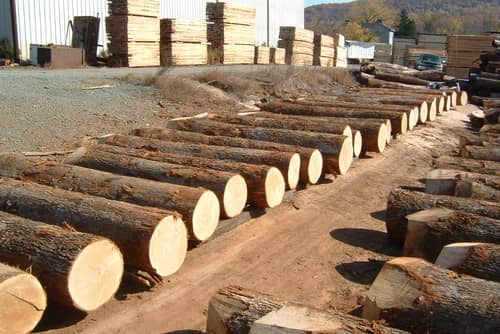
Numerous types and species of wood can be used as material to build a log cabin. Just in the U.S., there are over 300 types of woods available. Of course, not all of these types can serve as great building materials. That’s why it’s important to choose the right ones that can be used from non-usable wood.
Out of those 300, 7 can be utilized in the building of a log cabin, and only 3 are actually being used in the newer construction plans and designs. Other than the wood type, you should pay attention to how well the wood resists insects, how much it warps and shrinks, its durability, and even aesthetics, meaning the color and texture.
> Buy Log Cabin Book “Log Cabin Years” HERE <
Log Cabin Wood Species
It’s important to pay attention to the construction of wood species because each and every one has its own characteristics. Those specifications should be researched, so poor materials can be eliminated from the options pit. Pine, Cedar, Cypress, Spruce, Fir, Hemlock, Oak, and Poplar are some of the most commonly used species.
Many people think that, for example, red oak is the same as white oak when it comes to its characteristics and that they only differ in color. That, of course, isn’t the case. It’s the same for white and yellow pine and also for red and white cedar. Here are some of the most popular wood species listed and shortly described:
- Pine
Pine is softwood, and that’s why it is often used as a building material for log cabins. Softwoods are great for construction, especially if they have aged a bit. With aging, the tree becomes more resistant to decay. When it comes to subspecies of pine, yellow pine is more resistant than white pine is. A downside to pine is that its shrinkage rate is quite high, especially if it’s still fresh. That can cause shrinkage, settling, and cracks. This shouldn’t be that big of an issue, though, because pine is stable once it’s dry.
- Cedar
Cedar carries the title of the best logwood. That’s because it’s stunning, has a pleasant aroma, is resistant to insects and fungus without even being treated. Additionally, the cedars shrinkage rate is low, therefore it’s not necessary to dry it as much.
That makes the process less time-consuming. Our recommendation is to use cedar when building, especially for the interior. Cedar is a bit on the more expensive side, but it’s worth it when you consider everything good that it offers. If you can choose, always go for the older cedar wood because the oldness gives it extra sturdiness.
- Cypress
Because of its high cost, cypress isn’t used as frequently as other timbers. The high cost is for a reason, though. It’s hard to come by, and It has many great qualities for building a log cabin. Some are a low rate of shrinkage and resistance to insects, fungus, and deterioration. It also has large amounts of heartwood.
Heartwood, also called duramen, is the central wood type of tree that is mechanically strong, and resistant to decay, and can be less easily penetrated by wood-preservative chemicals than other types of wood. Because of a lot of heartwood embedded within the log, the cypress is very durable.
- Fir
Fir has several species, most of which can be used for cabin building. That’s why this kind of log is pretty accessible. Most fir species have lower shrinkage rates but are susceptible to decay, fungi, and insects. To help alleviate these concerns, you’ll need to treat fir logs.
The first step is to choose the type of log you will use for your log cabin. Once you have done that, you will see what amount of logs you need and how big and long they should be.
Related Article: Cheap Log Cabin Foundations: Choosing the Best Base
How Many Logs Are Required?
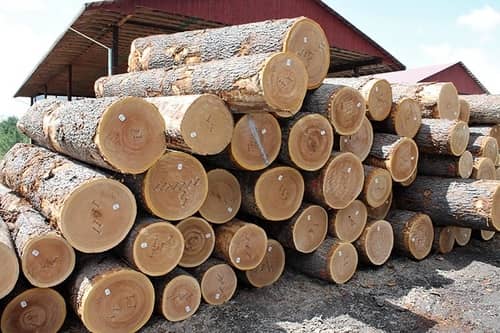
Here is an example: If all the logs are 10 inches in diameter, a log cabin measuring 20 × 24ft and 9ft in height will need around 60 logs. It’s smart to walk around your property and determine which trees you’ll utilize after deciding how many logs you will need for this project.
Search for trees that are uniform from every perspective and have similar diameters at both ends. The diameter of your logs should be between ten and twelve inches, with little to no curve. When it comes to a fifteen-foot-long tree, the tapering shouldn’t be around two inches. To keep track of how many trees you’ve chosen, make a note of each one as you walk around.
Felling Trees
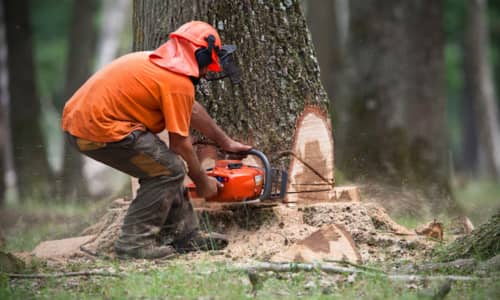
When chopping down trees, you should always use safety equipment. We recommend that you use a helmet that has a protective face shield, leg protection, eye protection glass, and steel-toe cap boots. This might sound dramatic, but having a tree fall on you with no safety equipment can even be deadly. Other than the injury-protecting equipment, you will need a chainsaw, a wedge, and an axe in order to complete the process of cutting down the trees.
Once you have determined how many and what type of trees your log house needs, the process of felling is the following. This is usually the most enjoyable aspect of cabin building, but it can also be one of the most dangerous.
Here are a few directions on how and when to fell down your logs:
- Logs need to be cut during the winter. Trees in the winter dry out more thoroughly, resulting in fewer splits and cracks in the future.
- Avoid cutting down trees in windy weather. Even if you have set aside a day to do this job, and end up being windy, it is better to wait until the wind is gone and complete the job responsibly, than to cut it in strong wind. When choosing where to start cutting, consider the direction where the tree is most probably lean. The cuts should be made on that side so that the tree falls towards that direction.
- Before cutting, you need to make sure there is enough space around you so that nothing gets damaged and no one gets hurt. Also, you should ensure you have a path to take once the tree starts falling.
- When the tree is cut down, log ends should be debarked and sealed by using paraffin wax. The process of debarking is done with a drawknife that peels the bark that is on the logs. The best way to do this is to sit on the log and pull the knife towards yourself at a 30-degree angle.
Note! We advise you to cut down between 2 or 5 additional trees. This is for preparation if other trees don’t dry or become infested. Additionally, make sure to choose a few different locations to cut wood in. That’s so you do not desert one patch of the forest and drastically interfere with the ecosystem.
> Buy Log Cabin Book “Building With Logs” HERE <
Storing Logs Properly
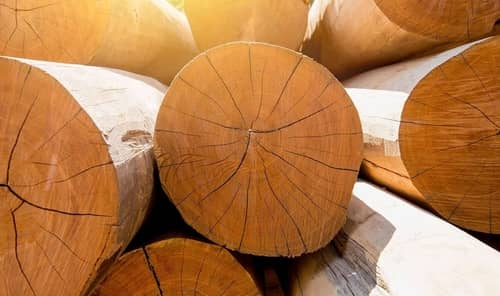
After the logs have been debarked, they should be gathered and placed in a dry place so they can begin their drying process naturally. Do people frequently wonder how long logs should be cured for? The answer is easy: as long as feasible. We would advise drying logs for a minimum of 6 months, but if you have the opportunity to not use these trees for several years, that would be ideal. Because of this, it is best to plan log cabin building a long time in advance.
To obtain the proper content of equilibrium moisture, logs must be dried in an area and climate in which the moisture point of the wood won’t be changed. It’s also vital to keep in mind that, considering the nature of wood and the weather, the equilibrium is a dynamic process that varies over time. Because of the changes, the log will continue to expand and contract during that time.
Before storing logs, it’s necessary to seal them at the edges. That’s because that’s where moisture evaporates the fastest, causing circle separation and fractures. Shellac, paraffin wax, latex paint, or specially designed end grain sealants can be used to seal the ends.
Logs must be stacked without touching the ground, so you may either lift them with skids or devote a few logs to lay the rest on.
Use Dry Logs
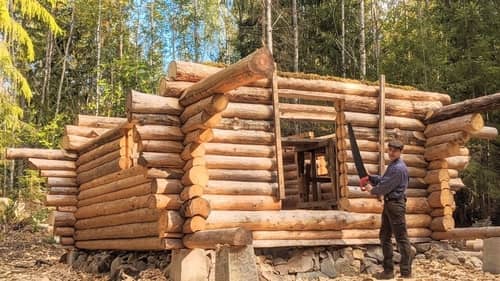
You should know have everything to build your log home after your logs have dried. To begin, you first must determine which foundation your log cabin requires. Shallow foundations, such as pads, strips, or raft foundations, are frequently sufficient for log cabins. Afterward, you’ll need to figure out what method you will use when building your log cabin. For example, to unite the edges, you can utilize a variety of building methods and notches.
You’ll need to roof your wood home after the walls have been completed. You’ll also need to select the roof’s pitch and materials. It’s possible that you’ll wish to install insulation in your log cabin. It’s important that you’ll do good insulation of your walls, but you’ll surely need to insulate flooring and roofing.
Cutting The Logs Without a Mill
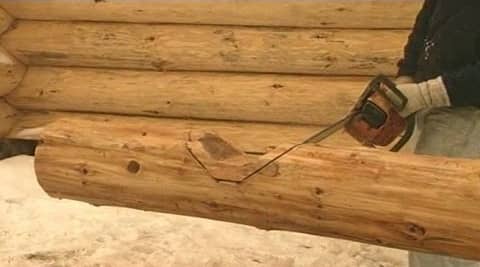
Even without a mill or ripping guide, ripped lumber and “puncheon logs” can still be cut. This can be done by cutting a V-shaped hole in the center of each of the two short logs. The width of the wood you wish to remove should be reflected in the V-notch. Those logs will be used to keep the log you want to pull attached to the ground. It’s best to place your lumber log in the V-notches once it has been skinned. Draw the horizontal and vertical rip lines along the length of the log and on both ends of it.
Drive a post into the ground far enough from the center to avoid getting hit by the saw blade at one end of the log. A double-headed nail, also known as a duplex nail, is used to secure it to the log. This will help support the log as you shred it and make removing the nail easier. Its simplest is to cut through the log and to the full length of the saw bar, then finish the cut.
Eave & Roofing
If you wish to have an overhang, remember that the exhaust vent support logs must reach beyond the walls during installation. Cutting the log too soon will require some retrofitting. An often used roofing material is sod which can be layered over with an inexpensive fiberglass sheet over the crown and folded multiple times.
Then follows a covering of high-quality plastic roofing, followed by another layer of low-cost tarp. The sod stems will develop into the top tarp, forming a strong bonded surface that reaches all the way to the crown. To prevent sliding on a steeply pitched roof, try using restraint logs.
For those who want to learn more, be sure to read How To Cut Logs For Log Cabin? Expert Explain.
FAQ: People Also Ask
Can you build a log cabin out of pine logs?
Yes! Pine, along with cedar, is one of the most commonly used wood species for a log cabin in the U.S. and Canada. Additionally, they are simpler to find than some more exotic timber types. Because of their availability and characteristics that allow building, they are widespread in the log cabin lover community
How long logs need to dry before being used to build?
You should cover the ends of the branches as soon they’ve been chopped down. Don’t wait days or even hours! The length of time it takes for the logs to dry depends on the wood species and their thickness. It usually takes at least one to two years to dry so the timber quality is actually good for building. The longer you can wait the better.
Final Thoughts
Using trees from your own property to construct a log cabin is usually a really fulfilling and pleasurable experience. You’re not only conserving natural resources, but you’re also lowering transportation expenses and being precisely aware of where your logs came from. Building a log cabin is one of the most satisfying projects you can undertake, as it results in a stunning, rustic-looking dwelling that will last for decades and most probably be something you leave to your children and grandchildren.


Your point of view caught my eye and was very interesting. Thanks. I have a question for you. https://accounts.binance.com/sk/register-person?ref=WTOZ531Y
Can you be more specific about the content of your article? After reading it, I still have some doubts. Hope you can help me. https://www.binance.info/ph/join?ref=FIHEGIZ8